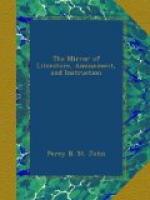We have the following picture of a country squire from Grose:—“His chief drink the year round was generally ale, except at this season, the fifth of November, or some other gala days, when he would make a bowl of strong brandy punch, garnished with a toast and nutmeg. In the corner of his hall by the fire-side stood a large wooden two-armed chair, and within the chimney corner were a couple of seats. Here at Christmas he entertained his tenants assembled round a globing fire made of the roots of trees and other great logs, and told and heard the traditionary tales of the village, respecting ghosts and witches, till fear made them afraid to move. In the mean time the jorum of ale was in continual circulation.”
Christmas Presents.—A friend of mine at Appleby, in Westmoreland, who is aware of my writing this article, says, “Pray recollect the old custom we have here of making little presents one to another. You know it is the practice here for little girls to send numerous presents to their sweethearts, secured as tightly with wax and brown paper as can be, that they may be some time guessing what it is before they open it. And if it is worth remarking, I would further remind you of the sending of shrid pies (which you know are very excellent) as presents to neighbours.”
In London enough is seen of the presents at Christmas, without describing them; and after a “day spent merrily,” they in the evening commence card playing, which is kept up till morning, generally speaking, and from thenceforth a whole run of merry days, till and beyond Twelfth Day.
Soon after Christmas Day we are apprized of Twelfth Day (which keeps us from dulness) by the icy cakes which everywhere appear in the pastrycook’s windows. And now I think I have as far as I am able fulfilled my promise, and I may perhaps conclude this article with wishing you and all your readers and correspondents a merry Christmas and a happy new year.
W.H.H.
[9] See MIRROR, p. 330.
* * * * *
RECOLLECTIONS OF MELROSE ABBEY.
(For the Mirror.)
“I do love these ancient ruins;
We never tread upon them, but we set
Our foot upon some reverend history.”
This fine ruin has a double interest attached to it, for, independent of that which is created by the antiquity and splendour of the edifice, the visiter should bear in mind that it is the Kennaquhair of the northern magician; and here the scenes so finely depicted in the Monastery are vividly brought to our recollection; it gives a “local habitation and a name” to some of the most interesting creations of Sir Walter Scott’s genius. The abbey is situated in a valley, surrounded by the Eildon hills. Some ruins of the abbey mill, with the dam belonging to “Hob Miller,” the father of the “lovely




